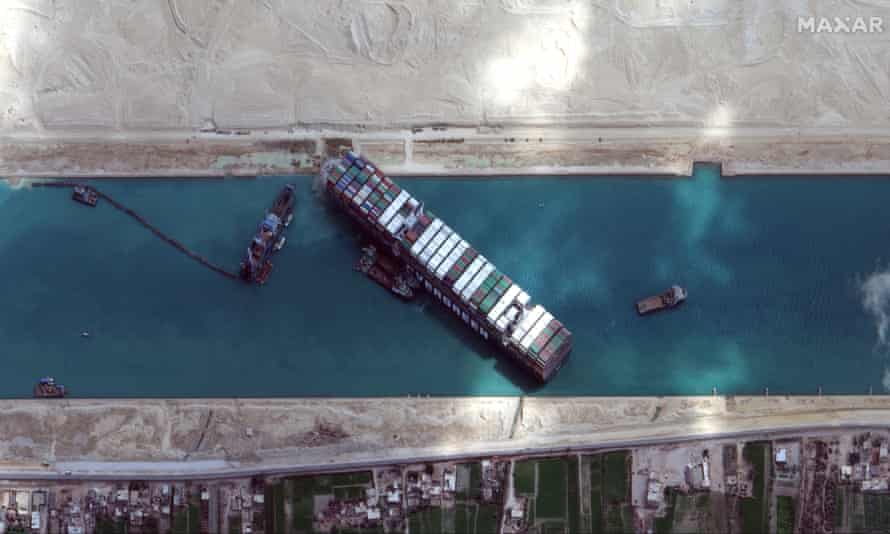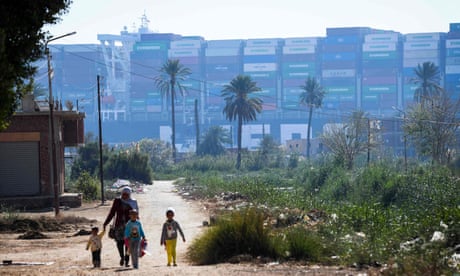GLOBALIZATION & DISASTER CAPITALI$M
Stranding of Ever Given in Suez canal was foreseen by manyAnalysis: As ships ballooned in size, worst-case scenario was flagged up by organisations such as OECD

Big ships require more time to salvage and more tugboats and
dredgers than what has been required in the past with smaller
vessels. Photograph: Maxar Technologies/AP
Michael Safi
@safimichael
Sun 28 Mar 2021
Michael Safi
@safimichael
Sun 28 Mar 2021
Authorities have blamed strong winds, possible technical faults or human error for the stranding of the Ever Given in the Suez canal.
But the running aground of the “megaship” – which salvage teams continued to try to free on Sunday as preparations were made for the possible removal of some of its containers – and the disruption of more than 10% of global trade, has been in the making for years longer according to analysts, who say an accident of this magnitude was foreseeable and warnings were ignored.
Over the past decade, out of the sight of most consumers, the world’s container ships have been quietly ballooning in size. A class of vessels that carried a maximum of about 5,000 shipping containers in 2000 has doubled in capacity every few years since, with dozens of megaships now traversing the ocean laden with upwards of 20,000 boxes.
Container ships have become huge fast, especially over the past decade. Other than the result of technological advances, analysts say the trend is a hangover from the high oil prices of the 2000s – which led shipping outfits to seek to maximise economies of scale – and the low-interest rates that followed the 2009 financial crash, which allowed companies to borrow the vast sums required to build vessels as long as skyscrapers are high.

Tugs, tides and 200,000 tons: experts fear Ever Given may be stuck in Suez for weeks
Read more
When the trend of ever-growing ships received popular attention, it was often through colourful press releases and awestruck news stories lauding the size of the vessels, the many Eiffel Towers’ worth of steel they required and the profits they promised the world’s shipping giants.
Comparatively less attention was granted to warnings of the risks such gigantic ships entailed, says Rory Hopcraft, a researcher at Plymouth University’s maritime cyberthreat research group.
“The ships are not just larger, they’re carrying more goods,” he said. “So rather than spreading the risks over three or four smaller ships, all your eggs are in one basket – it’s all tied up in one big ship.”
The ships’ rapid growth has outstripped the capacity of marine infrastructure to follow. The Panama canal was expanded at a cost of more than $5bn (£3.6bn) more than a decade ago to meet the size of new container ships – only to be left behind as even larger vessels rolled out of Asian shipyards.
“Half the world’s ports can’t even deal with ships this size,” Hopcraft said, describing a trend that leaves the overall supply chain more exposed to a range of threats including piracy and cyberattack. “If those terminals that can [accommodate megaships], aren’t able to service them for whatever reason – local power cuts or military action – then these ships can’t be serviced at all.”
The Suez canal has been in the process of expansion to allow for larger ships and two-way traffic at its northern end. But its southern side was still one-way and narrower: vulnerable when one of the largest container ships in the world tried to pass through on a windy morning.
Megaships have been described as a “bet on globalisation” made in the heady days of the mid-2000s, as a rising China and a US apparently at ease with outsourcing helped to drive a boom in global trade. Shipping companies expected the era would last and invested in new, vastly larger ships to accommodate it.
But the running aground of the “megaship” – which salvage teams continued to try to free on Sunday as preparations were made for the possible removal of some of its containers – and the disruption of more than 10% of global trade, has been in the making for years longer according to analysts, who say an accident of this magnitude was foreseeable and warnings were ignored.
Over the past decade, out of the sight of most consumers, the world’s container ships have been quietly ballooning in size. A class of vessels that carried a maximum of about 5,000 shipping containers in 2000 has doubled in capacity every few years since, with dozens of megaships now traversing the ocean laden with upwards of 20,000 boxes.
Container ships have become huge fast, especially over the past decade. Other than the result of technological advances, analysts say the trend is a hangover from the high oil prices of the 2000s – which led shipping outfits to seek to maximise economies of scale – and the low-interest rates that followed the 2009 financial crash, which allowed companies to borrow the vast sums required to build vessels as long as skyscrapers are high.

Tugs, tides and 200,000 tons: experts fear Ever Given may be stuck in Suez for weeks
Read more
When the trend of ever-growing ships received popular attention, it was often through colourful press releases and awestruck news stories lauding the size of the vessels, the many Eiffel Towers’ worth of steel they required and the profits they promised the world’s shipping giants.
Comparatively less attention was granted to warnings of the risks such gigantic ships entailed, says Rory Hopcraft, a researcher at Plymouth University’s maritime cyberthreat research group.
“The ships are not just larger, they’re carrying more goods,” he said. “So rather than spreading the risks over three or four smaller ships, all your eggs are in one basket – it’s all tied up in one big ship.”
The ships’ rapid growth has outstripped the capacity of marine infrastructure to follow. The Panama canal was expanded at a cost of more than $5bn (£3.6bn) more than a decade ago to meet the size of new container ships – only to be left behind as even larger vessels rolled out of Asian shipyards.
“Half the world’s ports can’t even deal with ships this size,” Hopcraft said, describing a trend that leaves the overall supply chain more exposed to a range of threats including piracy and cyberattack. “If those terminals that can [accommodate megaships], aren’t able to service them for whatever reason – local power cuts or military action – then these ships can’t be serviced at all.”
The Suez canal has been in the process of expansion to allow for larger ships and two-way traffic at its northern end. But its southern side was still one-way and narrower: vulnerable when one of the largest container ships in the world tried to pass through on a windy morning.
Megaships have been described as a “bet on globalisation” made in the heady days of the mid-2000s, as a rising China and a US apparently at ease with outsourcing helped to drive a boom in global trade. Shipping companies expected the era would last and invested in new, vastly larger ships to accommodate it.
Then came a financial crash, a populist western backlash against free trade and a lingering coronavirus pandemic that has put millions out of work.
Yet shippers have increased their bet, continuing to order giant new vessels that allow them to move more stuff with less fuel and crew, even as organisations such as the OECD have questioned the rationality of the trend.
There was a “complete disconnect of ship size development from developments in the actual economy”, the organisation said in a 2015 report, pointing out that ships were growing larger in “an economic climate that is generally depressed and at best stagnating”.
“The trade growth to absorb ship developments is currently absent,” the OECD paper said. “Shipping lines are building up overcapacity that will most likely be fatal to at least some of them.”
Yet shippers have increased their bet, continuing to order giant new vessels that allow them to move more stuff with less fuel and crew, even as organisations such as the OECD have questioned the rationality of the trend.
There was a “complete disconnect of ship size development from developments in the actual economy”, the organisation said in a 2015 report, pointing out that ships were growing larger in “an economic climate that is generally depressed and at best stagnating”.
“The trade growth to absorb ship developments is currently absent,” the OECD paper said. “Shipping lines are building up overcapacity that will most likely be fatal to at least some of them.”
It also warned of what is becoming clear on the banks of the Suez: that bigger ships are harder to salvage, requiring more time and more tugboats and dredgers than what has been required in the past with small vessels.
Should floating cranes be required to lighten the Ever Given by removing some of its 20,000 containers, they too would need to be large and work for longer, extending the salvaging process – and the blockage of one of the main arteries of global trade – for weeks at least.
It is a worst-case scenario that many saw coming. “As the ship gets bigger, everything just gets a little bit more complicated,” Hopcraft said.


No comments:
Post a Comment